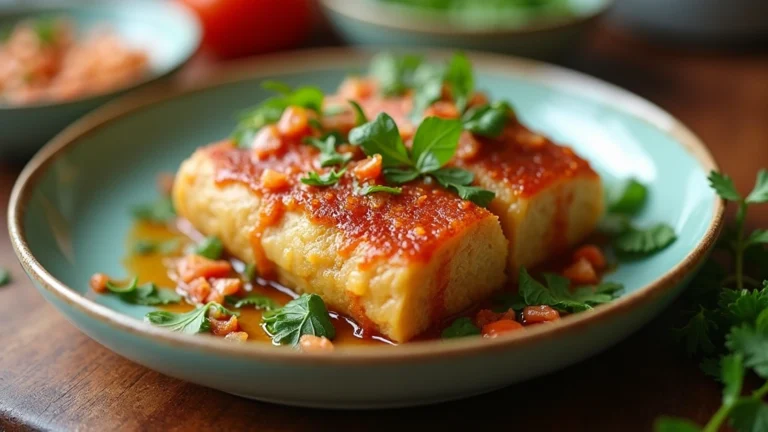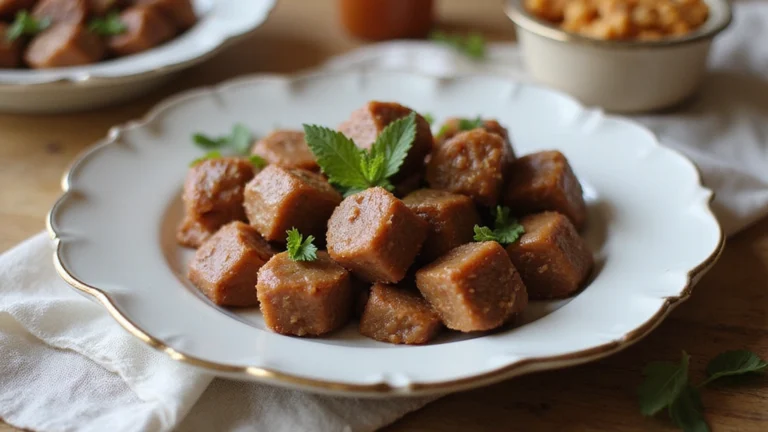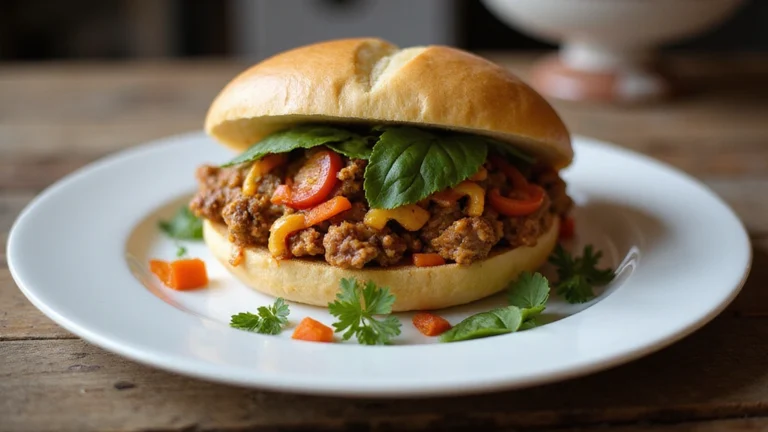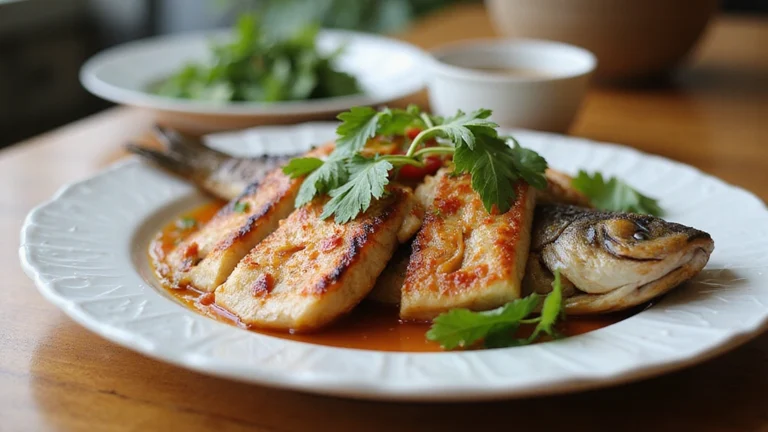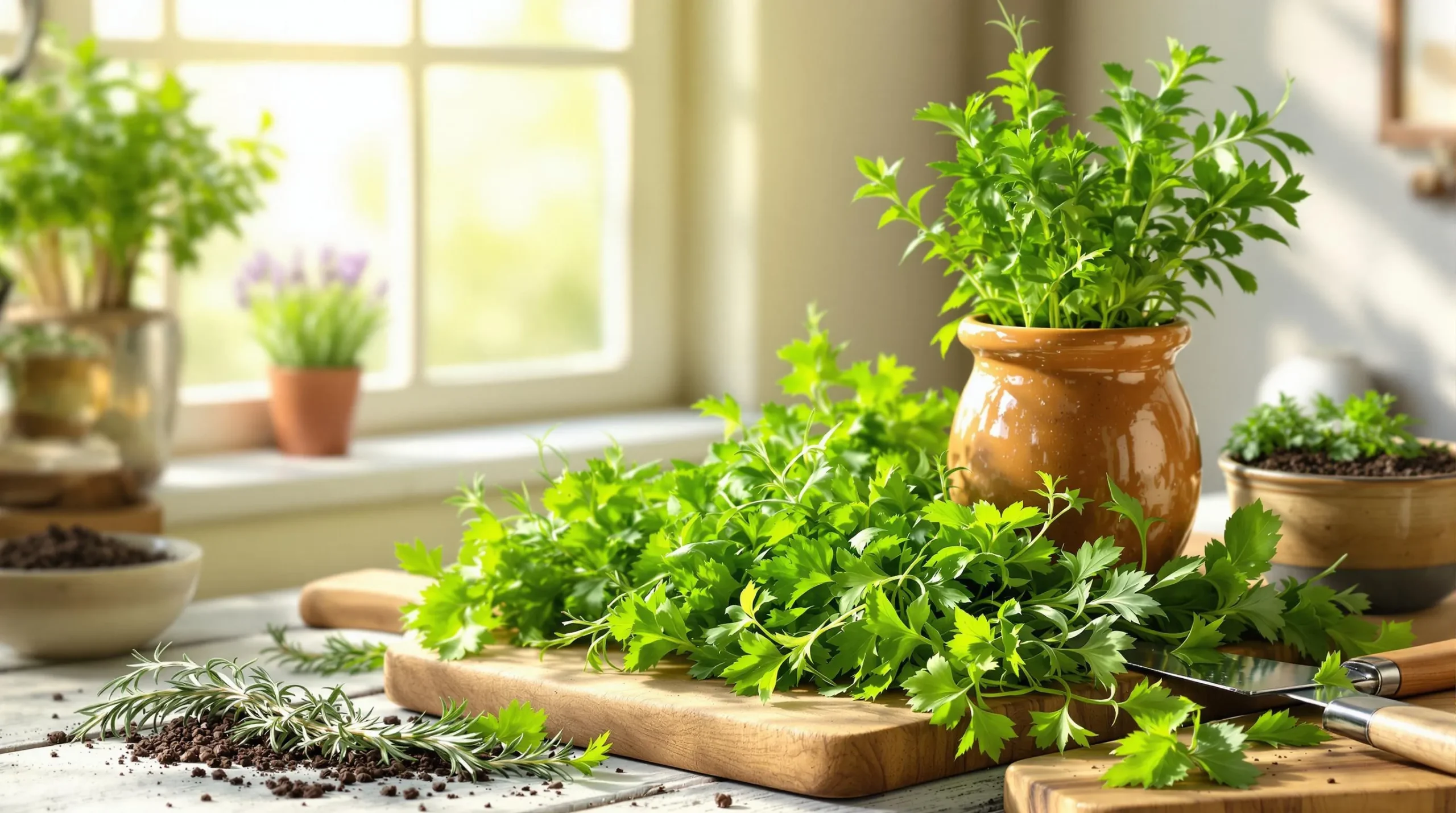
What Are French Herbs?
French herbs are the botanical backbone of traditional French cuisine embodying centuries of culinary heritage. These aromatic plants transform ordinary dishes into extraordinary culinary experiences through their distinctive flavors and aromas. The most celebrated French herbs include thyme rosemary tarragon parsley chervil chives sage and bay leaves each bringing unique characteristics to various recipes.
Thyme stands as perhaps the most quintessential French herb with its earthy slightly floral notes perfectly complementing meat dishes stews and sauces. Its versatility makes it indispensable in classic French recipes like coq au vin and bouef bourguignon. During my visits to Provence last summer I observed how local chefs would gently rub thyme between their fingers before adding it to dishes releasing its essential oils for maximum flavor.
Tarragon defines French cooking with its distinctive anise-like flavor that pairs magnificently with chicken fish and eggs. This herb forms the foundation of béarnaise sauce and tarragon vinegar both staples in French kitchens. The delicate licorice notes of French tarragon differ significantly from Russian tarragon offering a more refined flavor profile that French chefs prize above all others.
Rosemary with its pine-like fragrance and robust flavor thrives in the Mediterranean climate of southern France. This woody herb infuses roasted meats and potatoes with incredible depth and complexity. The sturdy stems serve dual purposes as flavor enhancers and as natural skewers for grilled vegetables and meats demonstrating the practical ingenuity of French cooking.
Parsley appears in countless French dishes both as a flavor component and garnish. The flat-leaf variety (persil plat) preferred in French cuisine delivers more pronounced flavor than curly parsley. This versatile herb forms part of the classic fines herbes blend and persillade a mixture of chopped parsley and garlic that elevates simple dishes to restaurant quality.
Bay leaves provide subtle depth to slow-cooked dishes stews and sauces. Their aromatic qualities develop gradually during cooking infusing broths with complex earthy notes. French chefs typically use dried bay leaves which concentrate the flavor and remove them before serving.
Chervil with its delicate anise notes similar to tarragon but milder contributes a sophisticated flavor to egg dishes sauces and soups. This herb appears frequently in springtime French cooking especially in the classic sauce ravigote.
Chives offer mild onion flavor without overpowering dishes making them perfect for delicate preparations like omelets soft cheeses and light sauces. Their beautiful purple flowers sometimes garnish salads adding both visual appeal and subtle flavor.
Sage although less prominent than other French herbs plays an important role in certain regional dishes particularly in Provence and alongside poultry dishes. Its velvety leaves and strong camphor-like aroma complement rich foods beautifully.
These herbs don’t just add flavor but connect modern cooking to centuries of French culinary tradition. When properly utilized they transform simple ingredients into memorable dishes capturing the essence of French gastronomy right in your kitchen.
The Classic French Herb Blend: Herbes de Provence

Herbes de Provence stands as one of the most iconic herb blends in French cuisine. This aromatic mixture brings the essence of southern France to your kitchen with its distinctive fragrance and versatile culinary applications.
History of Herbes de Provence
Contrary to what many believe Herbes de Provence is a relatively modern creation that gained commercial popularity in the 1970s. This blend originated from the sun-drenched hills of Provence in southeastern France where abundant wild herbs thrive in the Mediterranean climate. Local cooks traditionally gathered these herbs fresh from the countryside using them to enhance regional dishes like ratatouille bouillabaisse and grilled meats.
The commercialization of Herbes de Provence began when spice merchants recognized its appeal and started marketing pre-mixed dried versions. Interestingly the blend became more standardized outside of France than within the country itself. American chef Julia Child played a important role in popularizing this herb mixture in the United States through her influential cookbook “Mastering the Art of French Cooking” which introduced countless home cooks to the aromatic wonders of Provençal cuisine.
Traditional Herbs in the Blend
The classic Herbes de Provence mixture combines several key herbs that capture the essence of southern French cooking:
- Thyme: Provides earthy depth and forms the backbone of the blend
- Savory: Adds peppery notes with subtle pine undertones
- Marjoram: Contributes a delicate sweetness similar to oregano
- Rosemary: Delivers resinous pine-like aromatics and robust flavor
- Oregano: Brings Mediterranean warmth and slight bitterness
- Basil: Offers sweet and clove-like notes when dried
French versions typically stick to these traditional ingredients while North American blends often include lavender flowers. The addition of lavender creates a distinctly floral aroma that evokes the famous lavender fields of Provence though purists might argue this is more for tourist appeal than culinary authenticity.
Essential French Herbs and Their Flavors
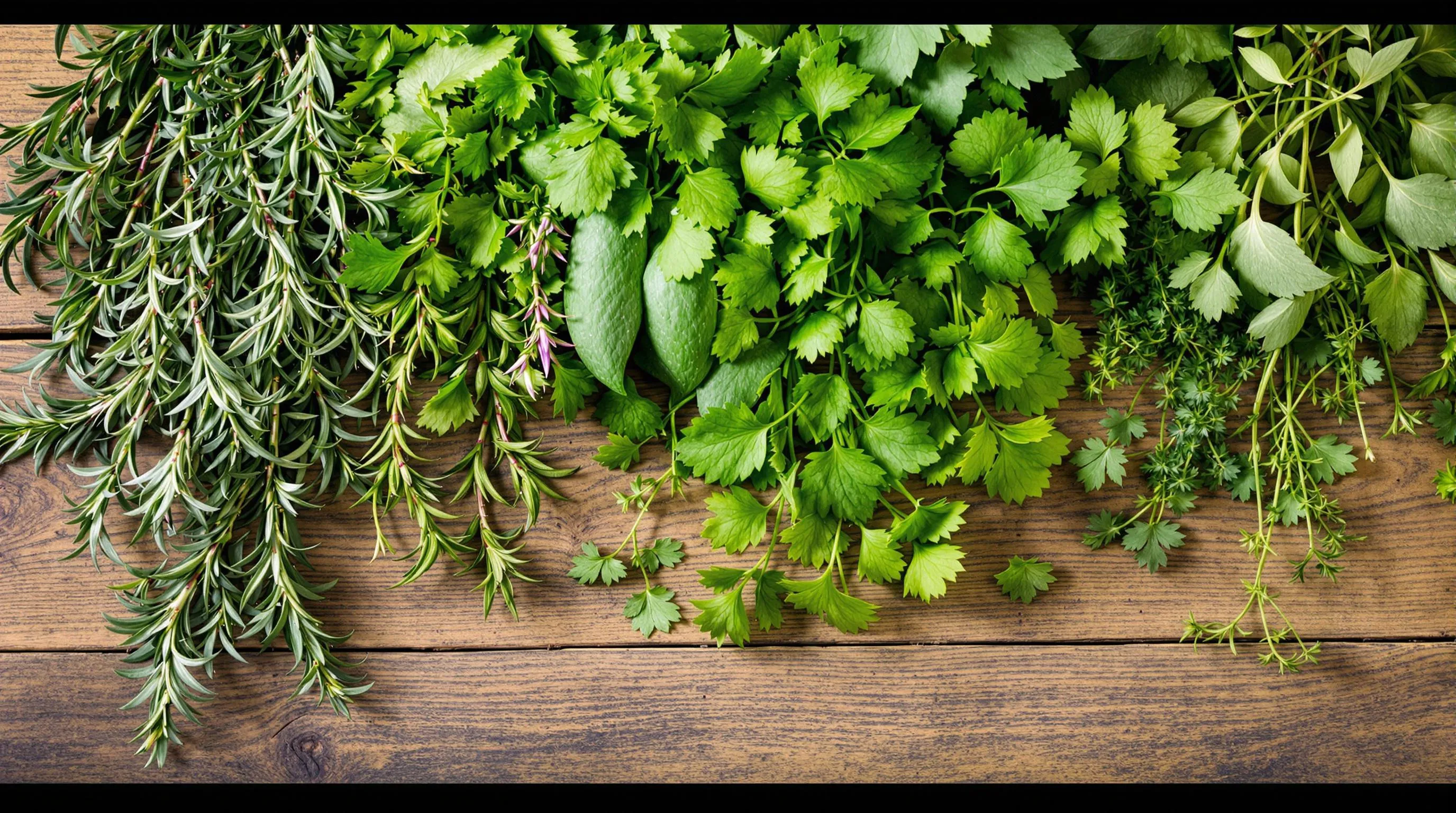
French cuisine owes much of its distinctive character to the careful selection and masterful use of herbs. These aromatic plants contribute depth complexity and nuance to dishes that might otherwise fall flat.
Thyme
Thyme stands as a cornerstone of French cooking with its delicate yet persistent flavor that enhances both simple and complex preparations. This woody perennial herb offers earthy minty notes with subtle floral undertones that develop beautifully during long cooking processes. You’ll find thyme essential in classic French dishes like coq au vin cassoulet and boeuf bourguignon where it infuses slowly simmered broths and sauces. Fresh thyme sprigs can be added whole to dishes and removed before serving or the tiny leaves can be stripped from stems and chopped for more immediate flavor release. Its robustness makes it ideal for roasted meats poultry and root vegetables while still being versatile enough to complement delicate fish preparations.
Rosemary
Rosemary delivers an intensely aromatic pine-like flavor that transforms ordinary dishes into memorable experiences. This needle-leaved herb contains potent essential oils that stand up to strong flavors making it perfect for lamb pork and game meats. You’ll recognize rosemary’s distinctive presence in traditional French dishes like navarin d’agneau (lamb stew) and throughout Provençal cuisine. The herb’s sturdy nature means it works exceptionally well in high-heat cooking methods including roasting grilling and sautéing. Fresh rosemary stems can even be stripped partially and used as aromatic skewers for meat or vegetables imparting flavor from within during cooking.
Tarragon
Tarragon possesses a unique anise-like flavor with subtle sweetness that makes it unmistakably French in character. This distinctive herb serves as the defining taste in béarnaise sauce and pairs magnificently with chicken eggs and seafood. French chefs prize tarragon for its ability to elevate simple dishes like the classic poulet à l’estragon (tarragon chicken) or oeufs brouillés (scrambled eggs). The herb’s delicate nature requires careful handling—add it toward the end of cooking to preserve its complex flavor profile. Fresh tarragon maintains significantly more nuance than its dried counterpart making it worth seeking out for authentic French preparations.
Marjoram
Marjoram offers a gentle sweet-pine flavor with citrus notes that brightens French cuisine without overwhelming other ingredients. This soft-leaved herb belongs to the oregano family but delivers a more refined delicate taste that French chefs use in soups stews and vegetable dishes. You’ll find marjoram particularly important in the cooking of southern France where it features prominently in herb blends and vegetable-forward recipes. The herb works exceptionally well with poultry white fish and Mediterranean vegetables like tomatoes zucchini and eggplant. Fresh marjoram leaves should be added toward the end of cooking as extended heat diminishes their subtle complexity.
Bay Leaf
Bay leaf contributes a complex tea-like aroma with subtle eucalyptus notes that forms the foundation of countless French stocks soups and braises. This glossy aromatic leaf releases its flavor slowly during cooking creating depth without dominating. You’ll find bay leaves essential in the traditional bouquet garni where they join with thyme and parsley to create a removable flavor bundle. French classics like bouillabaisse pot-au-feu and béchamel sauce depend on bay leaves for their characteristic taste profiles. The leaves should always be removed before serving as they remain tough and inedible even after extended cooking.
Chervil
Chervil delivers a delicate anise flavor with subtle parsley notes that makes it a prized finishing herb in refined French cuisine. This feathery-leaved herb belongs to the classic fines herbes blend alongside parsley tarragon and chives. You’ll discover chervil adding brightness to springtime dishes eggs veal and fish preparations throughout France. Its gentle flavor dissipates quickly with heat making it ideal for cold applications or as a last-minute addition to finished dishes. French chefs particularly value chervil for elegant soups like cream of chervil soup and in delicate butter-based sauces where its nuanced flavor can shine.
Parsley
Parsley provides a fresh grassy flavor with a slight peppery bite that balances and brightens heavy or rich French dishes. This versatile herb appears in countless French recipes from the rustic to the refined adding both flavor and visual appeal. You’ll find flat-leaf parsley (also called Italian parsley) preferred in French kitchens for its more robust flavor compared to the curly variety. The herb features prominently in persillade (a mixture of chopped parsley and garlic) remoulade sauce and as part of bouquet garni. Fresh parsley stems contain intense flavor ideal for stocks and broths while the chopped leaves make perfect finishing garnishes that contribute both color and taste.
How to Grow Your Own French Herbs
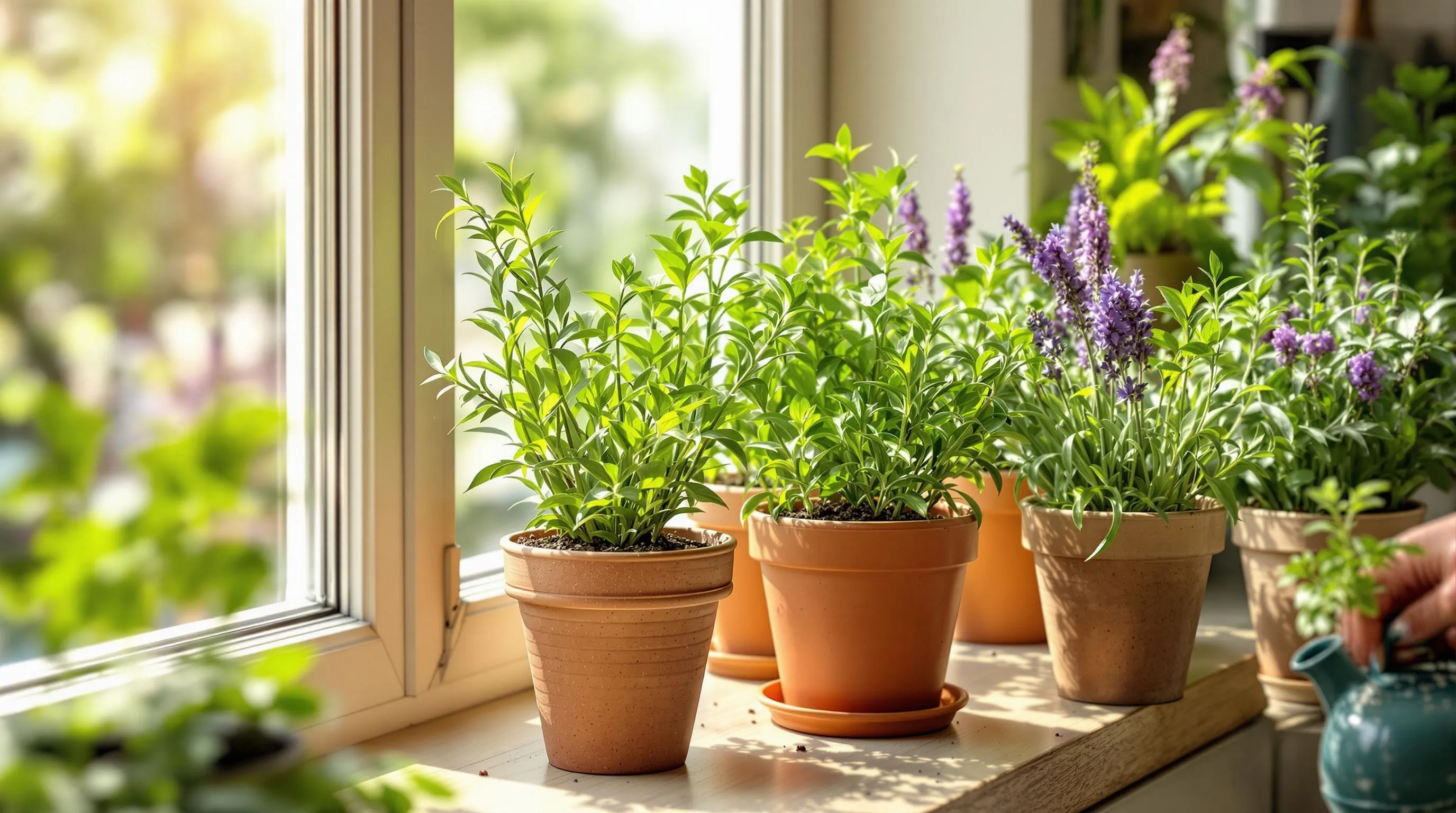
Growing your own French herbs at home allows you to enjoy the freshest flavors in your cooking while connecting to centuries of culinary tradition. You’ll discover that many classic French herbs are surprisingly easy to cultivate with a little knowledge and care.
Indoor Growing Tips
Transform any kitchen into a mini herb garden with these indoor growing strategies for French herbs. Select containers that provide adequate drainage to prevent root rot and use high-quality potting soil specifically formulated for herbs. Position your herbs near a south-facing window where they’ll receive at least 6 hours of sunlight daily—thyme rosemary and lavender particularly thrive in bright conditions.
For herbs with lower light requirements like parsley and chervil place them in east or west-facing windows. Water your indoor herbs when the top inch of soil feels dry avoiding oversaturation which can damage delicate root systems. Maintain proper humidity levels especially during winter months by placing pots on trays filled with pebbles and water.
Harvest your indoor herbs regularly to encourage bushier growth pinching stems just above a leaf node. Tarragon parsley and chives adapt particularly well to indoor environments making them excellent choices for year-round kitchen gardens. Feed your herbs with diluted organic fertilizer once a month during growing season to ensure robust flavor development and healthy foliage.
Outdoor Garden Planning
Design your French herb garden with intention placing sun-loving varieties like thyme rosemary and lavender in spots that receive full sunlight for at least 6-8 hours daily. Group herbs with similar watering needs together—Mediterranean herbs like rosemary thyme and savory prefer drier conditions while chervil and tarragon appreciate more consistent moisture.
Prepare your soil thoroughly before planting ensuring excellent drainage particularly for Mediterranean herbs which despise wet feet. Incorporate organic matter like compost to improve soil structure but avoid over-enriching the growing medium as many French herbs develop more concentrated flavors in slightly lean soil. Plant perennial herbs like thyme and rosemary in permanent locations where they can establish deep root systems and provide years of harvests.
Consider companion planting strategies to maximize garden health and productivity—rosemary repels cabbage moths making it an excellent neighbor for brassicas while thyme attracts beneficial pollinators. Space your herbs according to their mature size allowing room for proper air circulation which reduces disease pressure. Protect tender herbs like tarragon and chervil from intense afternoon sun in hot climates by providing light shade during the hottest parts of the day.
Harvest outdoor herbs in the morning after dew has dried but before the heat of the day when essential oil concentration reaches its peak. Mulch around established plants with gravel or crushed shells to suppress weeds maintain soil temperature and reflect light upward to intensify flavor development. With proper planning your outdoor French herb garden will yield abundant harvests from spring through fall connecting your kitchen directly to the rich traditions of French cooking.
Storing and Preserving French Herbs
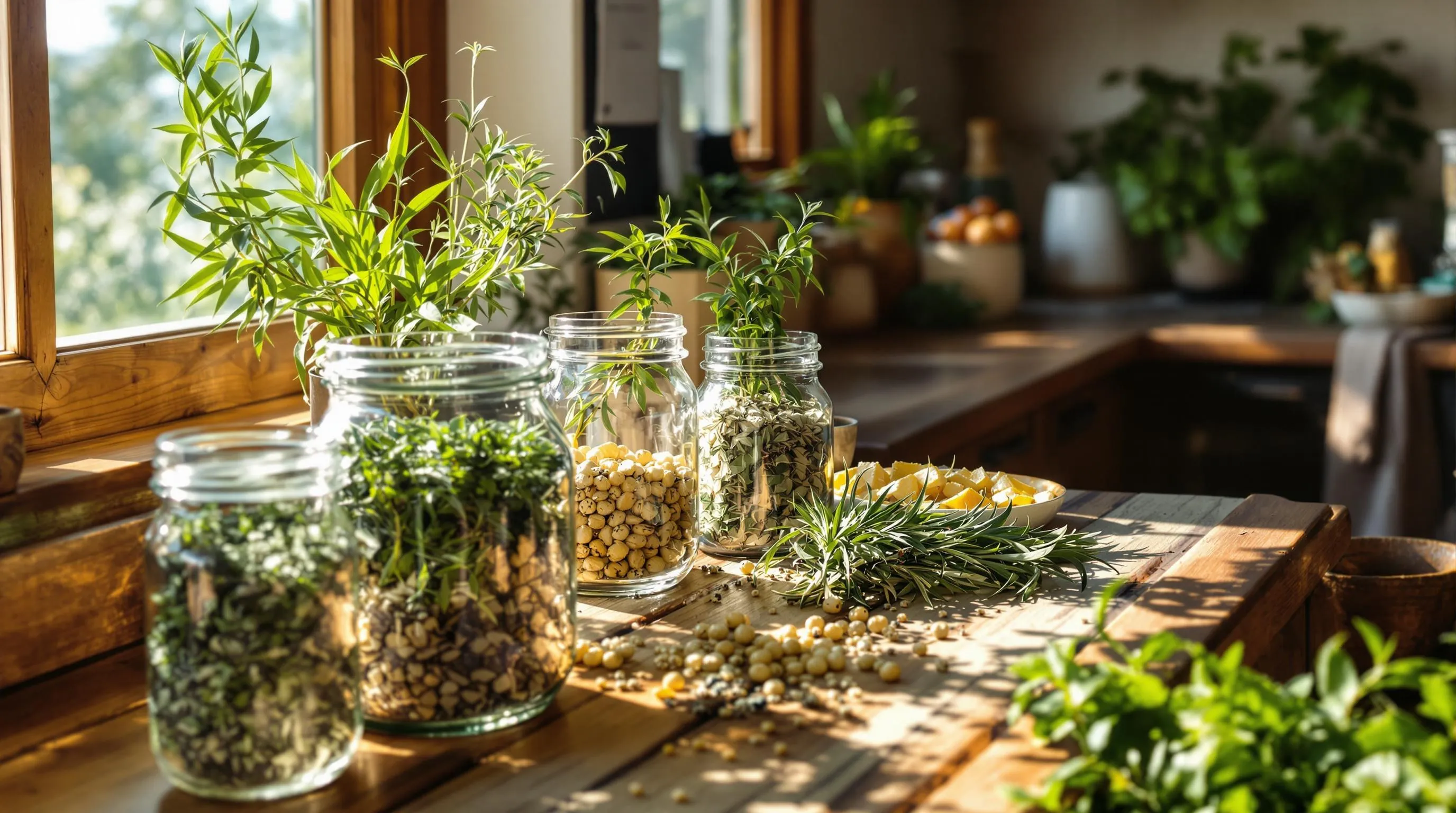
Proper storage and preservation methods are crucial for maintaining the vibrant flavors of French herbs long after harvest. The right techniques can help you enjoy these culinary treasures throughout the year even when fresh herbs aren’t readily available.
Drying Methods
Air drying represents the most traditional technique for preserving French herbs with centuries of history behind it. Begin by gathering small bunches of herbs like thyme rosemary and sage securing them with twine at the stems. Hang these bundles upside down in a warm dark location with good air circulation—ideally somewhere between 70-80°F with humidity below 60%. Your herbs will typically take 1-2 weeks to dry completely depending on the herb variety and environmental conditions.
Oven drying offers a faster alternative when time is limited. Spread herb leaves in a single layer on a baking sheet and place in an oven at the lowest possible temperature (usually around 170°F) with the door slightly ajar. Check frequently as herbs can dry in as little as 2-4 hours using this method. The herbs are ready when they crumble easily between your fingers but still retain their color.
Microwave drying provides the quickest option for small quantities. Place herb leaves between two paper towels and microwave in 30-second intervals until completely dry. This method works exceptionally well for delicate herbs like parsley and chervil that might lose flavor during longer drying processes.
Store your dried herbs in airtight glass containers away from direct sunlight and heat sources. Proper storage extends shelf life significantly—dried thyme and rosemary can last 1-3 years while more delicate herbs like chervil and tarragon retain optimal flavor for 6-12 months.
Freezing Techniques
Freezing herbs preserves their fresh flavors much more effectively than drying making it ideal for herbs like tarragon chervil and parsley. The simplest method involves washing and thoroughly drying your herbs before chopping them finely. Place the chopped herbs in freezer bags removing as much air as possible before sealing. Label each bag with the herb name and date for easy identification.
Ice cube tray preservation works wonderfully for herbs destined for soups sauces and stews. Fill each compartment of an ice cube tray halfway with chopped herbs then top with water or olive oil before freezing. Once frozen transfer the cubes to freezer bags for long-term storage. This method creates convenient pre-portioned herb servings you can drop directly into hot dishes.
Herb pastes offer another excellent preservation option. Process fresh herbs in a food processor with a small amount of olive oil until a smooth paste forms. The paste can be frozen in ice cube trays or small containers making it perfect for quickly adding intense flavor to dishes. This technique works particularly well with soft-leaved herbs like basil chives and parsley.
Blanching before freezing helps certain herbs retain their color and flavor. Briefly immerse herbs in boiling water for 5-10 seconds then immediately transfer to an ice bath. After drying thoroughly pack the blanched herbs into freezer containers. This extra step particularly benefits herbs with higher water content like parsley and chives.
Cooking with French Herbs
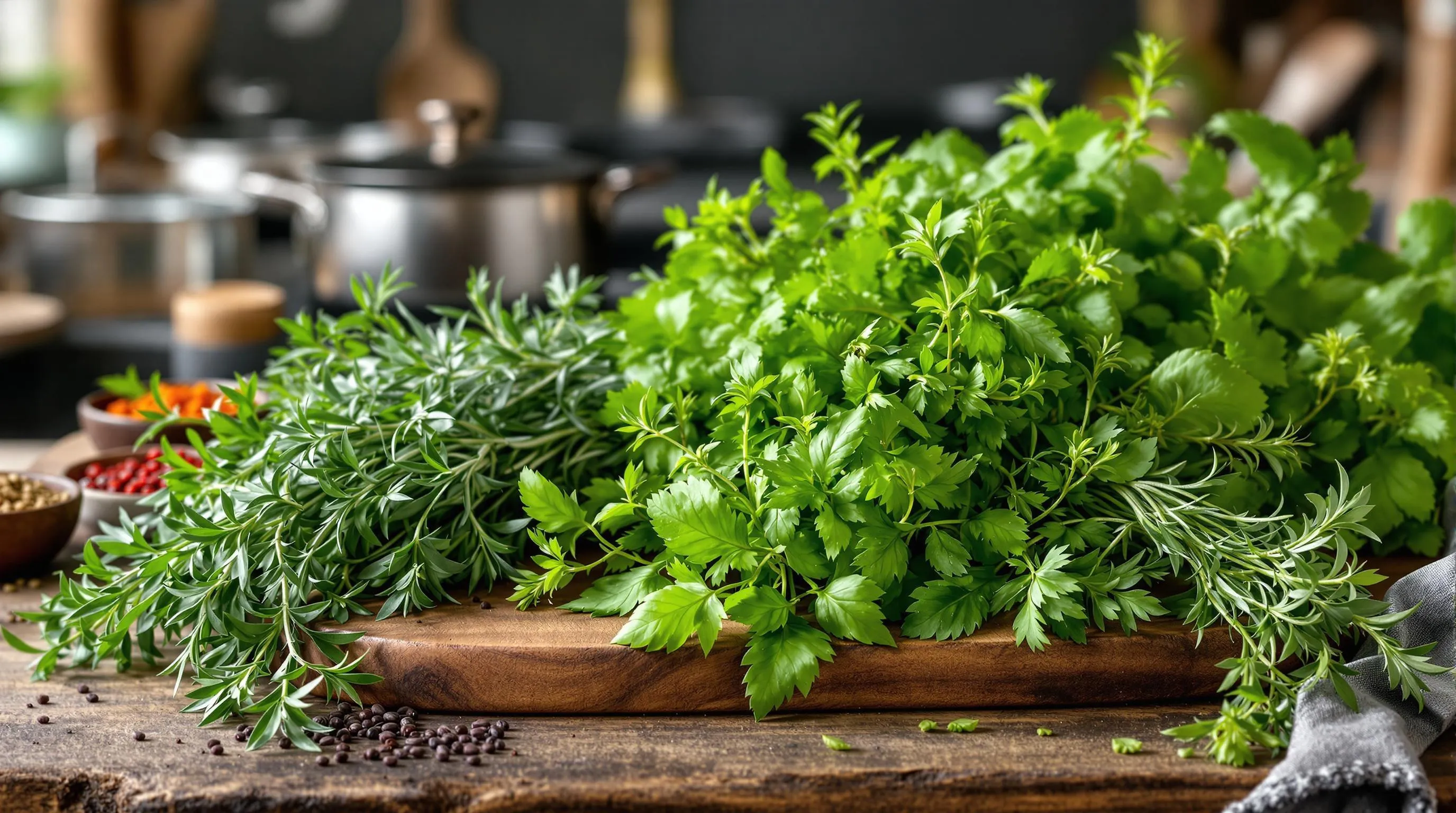
French herbs transform ordinary ingredients into extraordinary dishes with their distinctive aromas and flavors. Learning how to pair these herbs with various foods unlocks the secrets of authentic French cooking right in your own kitchen.
Meats and Poultry Dishes
French herbs elevate meat and poultry dishes from simple to sublime. Thyme shines when paired with roasted chicken, imparting an earthy depth that permeates the meat during cooking. Try adding sprigs of rosemary to lamb for a fragrant pine essence that cuts through the richness. When preparing beef dishes like boeuf bourguignon, a bouquet garni with bay leaves, thyme, and parsley stems creates a complex foundation of flavor. Tarragon becomes magical when used with chicken, especially in the classic poulet à l’estragon where its anise notes balance the cream sauce. For pork preparations, herbes de Provence create a fragrant crust when pressed into the meat before roasting. Game meats benefit from stronger herbs like rosemary and sage which stand up to their robust flavors while adding aromatic counterpoints.
Seafood Applications
The delicate nature of seafood calls for thoughtful herb pairings that enhance without overwhelming. Chervil brings a subtle anise flavor to fish dishes, particularly effective in a butter sauce drizzled over sole or trout. Fresh parsley brightens seafood stews like bouillabaisse, adding color and freshness to the finished dish. Tarragon makes an excellent partner for lobster and scallops, its distinctive flavor complementing the natural sweetness of shellfish. For Mediterranean-inspired fish dishes, a light touch of thyme and rosemary evokes the coastal regions of southern France. Chives add a mild onion note to butter sauces for fish without dominating the palate. When preparing moules marinières, bay leaves and thyme in the steaming liquid infuse the mussels with aromatic complexity that balances their briny character.
Vegetable Preparations
French herbs transform humble vegetables into standout dishes worthy of center stage. Tarragon brings unexpected dimension to roasted carrots, its anise notes creating a sweet counterpoint. Fresh chervil elevates simple green salads with its delicate flavor that whispers rather than shouts. Thyme works wonders with mushrooms, drawing out their earthiness in a classic duxelles preparation. For ratatouille, the quintessential Provençal vegetable stew, herbes de Provence create the authentic flavor profile that makes this dish instantly recognizable. Chives add bright punctuation to potato dishes, particularly effective in a classic French potato salad dressed with vinaigrette. Marjoram brings gentle sweetness to summer squash and eggplant, complementing their mild nature. When preparing haricots verts, a light touch of savory enhances their garden freshness while maintaining their delicate character.
Soups and Stews
The slow-simmered nature of soups and stews creates the perfect canvas for French herbs to develop their full potential. Bay leaves form the aromatic backbone of vegetable and beef stocks, imparting subtle depth during long cooking periods. Thyme releases its earthy essence gradually into soupe à l’oignon, the classic French onion soup topped with crusty bread and melted cheese. For pistou, the French version of pesto added to vegetable soup, fresh basil provides a vibrant finishing touch that brightens the entire dish. Chervil adds delicate complexity to cream-based soups, particularly vichyssoise, where it complements the subtle flavor of leeks and potatoes. When preparing pot-au-feu, the traditional French boiled dinner, a bouquet garni containing parsley stems, thyme, and bay leaves creates a fragrant broth that infuses the meat and vegetables. Savory brings its distinctive peppery notes to lentil soups, cutting through the earthiness with its bright flavor profile.
Creating Your Own French Herb Blend
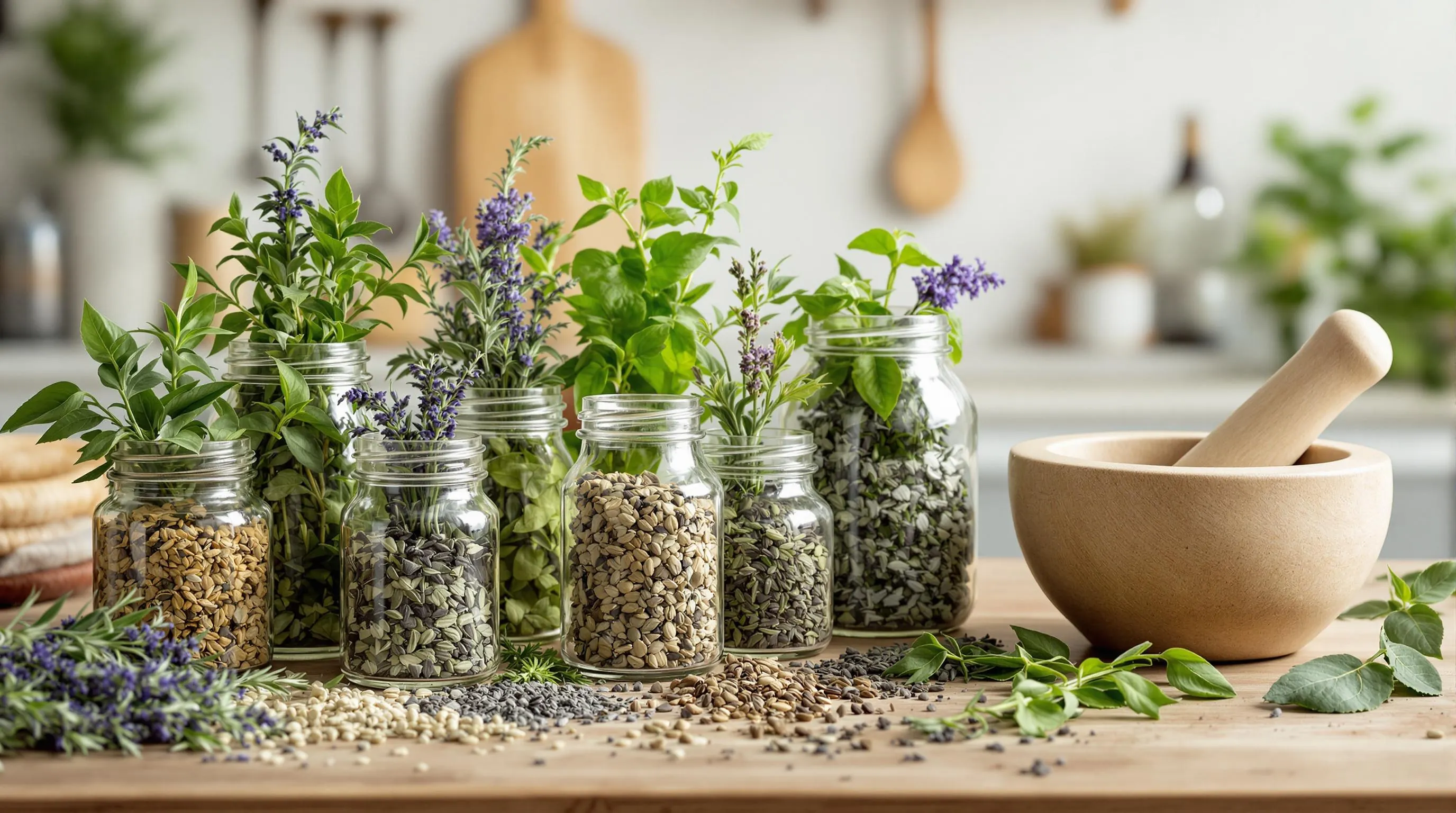
Making a personalized French herb blend allows you to customize flavors to your taste preferences while embracing the essence of French cuisine. With a few quality ingredients and simple steps you can create authentic blends that rival store-bought versions.
Ingredients
- 2 tablespoons dried thyme
- 1 tablespoon dried rosemary (crushed or ground)
- 1 tablespoon dried savory
- 1 tablespoon dried marjoram
- 1 tablespoon dried oregano
- 1 tablespoon dried basil
- 1 teaspoon dried lavender flowers (optional)
- 1 teaspoon dried fennel seeds (optional)
- 1 teaspoon dried sage (optional)
- ½ teaspoon dried bay leaf (crushed)
Instructions
Begin by gathering all your dried herbs ensuring they’re fresh and aromatic for the best flavor profile. Measure each herb carefully according to the quantities listed above adjusting amounts based on your personal preferences. Combine all herbs in a small bowl gently mixing them together with a spoon or whisk.
Transfer your herb mixture to a mortar and pestle crushing the herbs slightly to release their essential oils and meld the flavors. This step creates a more cohesive blend while intensifying the aromatic qualities of your mixture. For a finer texture pulse the herbs briefly in a spice grinder but avoid over-processing which can diminish their potency.
Store your completed herb blend in an airtight glass container away from direct sunlight and heat. Glass jars with tight-fitting lids work exceptionally well for preserving the freshness and potency of your blend. Label your container with the date and contents for easy reference in your kitchen.
Your homemade French herb blend will maintain optimal flavor for about 6 months though it remains usable for up to a year. Rub a small amount between your fingers periodically to check for aroma intensity which indicates freshness. Replace the blend when the fragrance diminishes significantly or the color fades.
Experiment with different ratios of the core herbs to create variations that complement exact dishes. Adding more rosemary creates a blend ideal for lamb dishes while increasing the thyme percentage works wonderfully with chicken recipes. The optional lavender adds a distinctive Provençal character perfect for grilled vegetables and Mediterranean-inspired dishes.
Health Benefits of French Herbs
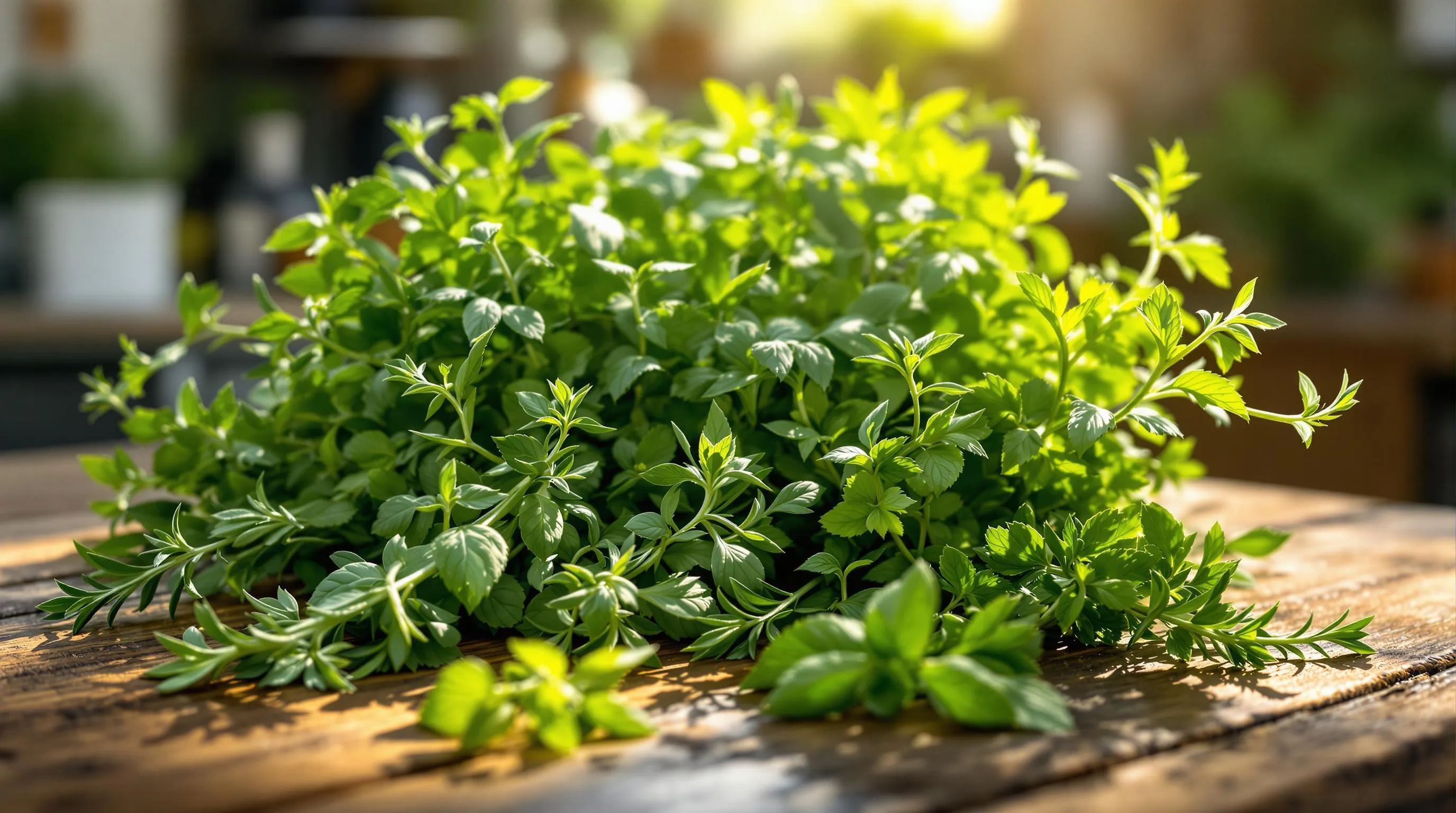
French herbs offer more than just culinary delights; they provide many health benefits that have been recognized for centuries. These aromatic plants contain powerful compounds that can enhance your wellbeing while adding distinctive flavors to your meals.
Antioxidant Properties
Many French herbs are packed with antioxidants that help combat oxidative stress in your body. Thyme contains thymol which exhibits strong antioxidant effects protecting cells from damage. Rosemary features carnosic acid and rosmarinic acid both powerful compounds that neutralize harmful free radicals. Research shows that adding just one tablespoon of fresh rosemary to your meals can provide a important antioxidant boost equivalent to taking a supplement.
| Herb | Key Antioxidant Compounds | Relative Antioxidant Power |
|---|---|---|
| Rosemary | Carnosic acid Rosmarinic acid | Very high |
| Thyme | Thymol Carvacrol | High |
| Sage | Rosmarinic acid Carnosol | High |
| Tarragon | Caffeic acid Quercetin | Moderate |
Anti-inflammatory Benefits
The anti-inflammatory properties of French herbs can help reduce chronic inflammation associated with various health conditions. Tarragon contains eugenol which has been shown to decrease inflammatory markers in laboratory studies. Parsley offers luteolin a flavonoid that helps reduce inflammation throughout your body. Regular consumption of these herbs may help manage symptoms of inflammatory conditions and promote overall wellness.
Digestive Support
French herbs have long been used to aid digestion and soothe digestive discomfort. Fennel seeds relax the digestive tract muscles helping to reduce bloating and gas. Thyme supports healthy gut function by promoting beneficial bacteria while inhibiting harmful pathogens. Chervil stimulates digestive juices improving nutrient absorption from your meals.
Immune System Enhancement
Boosting your immune system becomes easier with regular consumption of French herbs. Thyme oil contains compounds that strengthen resistance against common pathogens. Rosemary enhances circulation which helps immune cells reach their targets more efficiently. Bay leaves contain unique compounds that activate immune responses when needed.
“I’ve noticed my clients who regularly cook with fresh herbs like thyme and rosemary tend to report fewer seasonal illnesses” shares Liam Kohn. “One family I worked with incorporated a daily pinch of dried thyme into their morning smoothies during winter months and experienced their healthiest season in years.”
Cognitive Benefits
Your brain health can benefit significantly from certain French herbs. Rosemary improves memory and concentration by increasing blood flow to the brain. Studies indicate that even the aroma of rosemary can enhance cognitive performance on memory tasks. Sage contains compounds that inhibit the breakdown of acetylcholine a neurotransmitter important for memory and learning.
Heart Health Support
Supporting your cardiovascular system becomes easier with French herbs in your diet. Tarragon helps regulate blood pressure through its potassium content and natural compounds. Parsley acts as a natural diuretic helping to reduce fluid retention and lower blood pressure. Thyme contains compounds that help relax blood vessels improving circulation throughout your body.
Antimicrobial Effects
Many French herbs possess natural antimicrobial properties that have been utilized long before modern antibiotics. Thyme oil effectively fights common bacteria including those that cause food poisoning. Rosemary extract has been shown to inhibit the growth of foodborne pathogens making it a natural food preservative. Sage demonstrates activity against various microorganisms including those affecting oral health.
Where to Buy Quality French Herbs

Finding exceptional French herbs can transform your cooking from ordinary to extraordinary. Sourcing these culinary treasures requires knowing where to look and what to look for to ensure you’re getting authentic high-quality herbs.
Specialty Food Stores
Specialty food shops often carry a curated selection of premium French herbs. These establishments typically import directly from France or work with reputable suppliers who maintain strict quality standards. The staff at these stores usually possess extensive knowledge about their products and can guide you toward the most aromatic and flavorful options. Many specialty stores also offer Herbes de Provence blends that are properly balanced according to traditional recipes rather than mass-produced versions with artificial additives.
Farmers Markets
Local farmers markets provide an excellent opportunity to purchase freshly harvested French herbs. Speaking directly with growers allows you to learn about cultivation methods and harvesting practices that affect flavor profiles. The herbs you’ll find at farmers markets are typically harvested at peak freshness just days or even hours before sale. Establishing relationships with local herb farmers can lead to valuable insights about seasonal availability and optimal usage tips for your culinary creations.
Online Retailers
Many online retailers specialize in importing authentic French herbs and spice blends. These businesses often work directly with small-scale farmers in Provence and other regions of France to ensure authenticity and quality. When ordering online look for detailed information about the herb’s origin harvest date and storage recommendations. Reputable online herb merchants typically provide extensive product descriptions and customer reviews that help you make informed purchasing decisions.
French Specialty Importers
Dedicated French food importers offer some of the most authentic herb selections available outside of France. These companies maintain close relationships with French producers and understand the importance of proper handling and packaging to preserve delicate aromatic compounds. Many importers supply both retail consumers and high-end restaurants ensuring their products meet professional culinary standards. The selection available through these channels often includes regional herb varieties that are difficult to find elsewhere.
Growing Your Own
While not technically “buying” herbs starting your own French herb garden provides the freshest possible ingredients. Many French herb seeds and seedlings are available through specialized nurseries and online seed suppliers. Cultivating your own herbs connects you directly to the terroir concept so important in French cuisine. Even apartment dwellers can grow small pots of thyme tarragon or chervil on a sunny windowsill for year-round access to fresh flavors.
What to Look For When Buying
Quality French herbs display vibrant colors robust aromas and proper texture regardless of where you purchase them. Fresh herbs should look crisp and lively without any yellowing browning or wilting. Dried herbs should maintain their distinctive color rather than appearing gray or faded which indicates age or improper storage. The aroma should be immediately recognizable and potent when you crush a leaf between your fingers.
“I once drove two hours to a specialty French importer after discovering their hand-harvested Herbes de Provence transformed my ratatouille from good to extraordinary,” shares Liam Kohn. “The difference in flavor compared to supermarket varieties was remarkable—like comparing a fine wine to grape juice.”
Seasonal Considerations
Understanding the seasonal availability of French herbs helps you purchase them at their peak quality. Spring brings tender chervil and delicate chives while summer offers robust rosemary and thyme bursting with essential oils. Fall harvests often yield the most intensely flavored bay leaves and winter is ideal for purchasing dried herb blends created from summer’s bounty. Planning your herb purchases according to these natural cycles ensures you’re getting ingredients at their flavor pinnacle.
Conclusion
French herbs stand as pillars of culinary excellence offering both exceptional flavor and remarkable health benefits. By incorporating these aromatic treasures into your cooking you’ll connect with centuries of French gastronomic tradition while elevating everyday meals to extraordinary heights.
Whether you’re crafting a classic bouquet garni growing your own herb garden or creating a personalized blend the journey with French herbs is endlessly rewarding. From thyme’s earthy notes to tarragon’s distinctive anise flavor each herb brings its unique character to your table.
Remember that quality matters when sourcing these herbs. With proper storage and preservation techniques you can enjoy their vibrant flavors year-round. Embrace these botanical wonders and watch as they transform your culinary creations with that unmistakable French flair.
